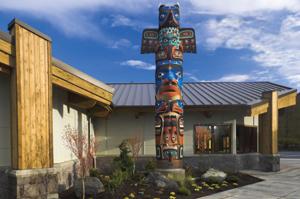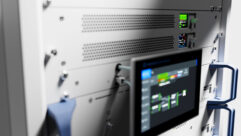

Not Your Average Deli
When the Jamestown S’Klallam Tribe marked the opening of the Tribal Longhouse Market and Deli on a cloudy Pacific Northwestern day in early May 2008, it represented an important step forward for the Washington tribe’s casino and resort operation.
So the proposed 11,000-square-foot retail store and six-pump service station had to do more than act as a simple point of sale. It needed to provide a high-quality experience that integrated seamlessly with other resort properties. Networked digital signage, linked to the 7Cedars Casino via fiber-optic cable, was the solution.
CHALLENGE: Link a newly built retail outlet to a growing casino and resort in order to ensure consistent messaging and promotion.
SOLUTION: Connect the two with fiber optic cabling and put everything on a centralized digital signage network.
When the Jamestown S’Klallam Tribe marked the opening of the Tribal Longhouse Market and Deli on a cloudy Pacific Northwestern day in early May 2008, it represented an important step forward for the Washington tribe’s casino and resort operation.
The tribe has operated the 7Cedars Resort and Casino for years. Located about 52 miles west of Seattle, the casino and resort operation has emerged as a vital economic engine for the tribe and the broader Sequim, Wash., community. The Tribal Longhouse Market and Deli was designed to play an important role in driving business to the casino and attendant properties.
“We have three customer bases that don’t always overlap,” explains Jerry Allen, assistant general manager of the 7Cedars Casino. “We’re trying to market all of our multiple properties. And clearly as our resort comes in, as that gets built out, we have to serve that task as well.”
A half-mile of fiber links the digital signage network in the Tribal Longhouse Market and Deli with the 7Cedars Casino.
NATIVE CHALLENGE
From the beginning, the Tribal Longhouse Market and Deli project emphasized the unique culture and image of the Jamestown S’Klallam Tribe. The front of the building features three tall totem polls, carved under the direction of tribal artist Dale Faulstich. Large bays of windows provide a sweeping view of Sequim Bay and the surrounding woods.
Inside, the market features an open and sophisticated look, with soaring ceilings and large windows. The natural wood post-and-beam architecture is augmented by stone countertops. The attractive design provides a compelling backdrop for the tribe’s retail operation, but it presented something of a challenge for Triamp Group, the AV services and installation firm hired to build out the extensive AV infrastructure for the $12 million store.
“They are not the first tribe to create a longhouse-style store, but nobody has done it with digital signage, at least not to this scale,” says Kevin Hill, the Triamp senior partner who managed the AV project. “For anyone to spend that type of money on a tribal gas station is pretty impressive. I’ve been up the West Coast, the East Coast, and the Midwest and have never seen a tribal store like this.”
Allen says the Longhouse Market’s high-end aesthetic is designed to integrate with the existing casino and a new resort, currently under construction. “When we did the store, it had to match the quality that the resort was going to deliver,” Allen says. “We couldn’t put a 7-Eleven down there and a couple of kiosks and have the same experience. When we were thinking about it long term, the store was sort of a gateway for the way people feel about the resort.”
DIGITAL SIGNAGE DILEMMA
Thanks to a thoughtful building design and roomy AV budget, Triamp Consulting faced few installation challenges at the Tribal Longhouse Market and Deli. The biggest challenge, says Jerry Allen, 7Cedars assistant general manager, was acquiring, managing, and scheduling all the content to be displayed across the store’s more than 20 flat-panel displays.
That’s not an unusual problem, says Seam Milstead, product manager for Planar Systems’ CoolSign digital signage product line. He says businesses new to digital signage often underestimate the scope and complexity involved in managing content bound to dozens or even hundreds of individual displays. So how should your client prepare for an aggressive digital project?
1. Formulate a strategy. Define the company’s messaging goals up front, then shape the physical and content deployments to match. Companies that deploy without such forethought can find themselves backing out of ill-considered deployments.
2. Start sourcing early. Moving to digital signage means capturing and entirely new collection of content for presentation. That means reaching out to vendors’ marketing departments for videos, brand imagery, and other content. Try to have the content lined up a full month before lighting up the system.
3. Tune the presentation. Determine how long visitors are to be in the “signage zone” then tune the content loops to suit. A 4- to 7-minute average customer visit, for example, would suggest a content loop of 3 to 5 minutes before the presentation repeats. Individual messages should generally be kept under 15 seconds in length. It’s also a good idea to break up the adverts with information content, such as news, weather, or entertainment.
4. Shuffle the deck. You can’t, and shouldn’t, run unique content all day long. Repetition, after all, is a cornerstone of effective advertising. But you should shuffle the play back of individual messages to keep the rotation fresh.
5. Pull it together. As digital signage projects get larger, the task of slinging all the content and messaging gets tougher. If the client expects to scale, look to integrate the signage system into product databases. That way, when the price of a 12-pack of Budweiser goes up 40 cents, the displayed promotions reflect the proper price.
Designed by Mike Gentry of Gentry Architecture, the spacious interior employs wide, hollow wood columns and beams that carry everything from HVAC and power to video and data cabling. For Hill’s team, the building design eased the task of linking 20 LCD and plasma video displays and 40 Tannoy DI5T surface mounted speakers to a Magenta Research Mondo Direct 16×32 HD video matrix switcher located in the store’s secure AV utility closet.
The open floor plan did require installers to run cable up through the floor. But with the newly built structure, Triamp’s team of four installers enjoyed easy access.
“We’re always the last guys in, like most projects, so we’re always scrambling to get things done. But this project was actually pretty smooth,” Hill recalls. “There was plenty of room to move around in there.”
With its bay-facing glass wall and glass door entrance, the space posed some ambient light and glare challenges. Hill says Sony LCDs were selected in part for their high brightness levels and contrast ratios, as well as for their burn-in characteristics—critical for an installation that’s expected to run 24 hours a day. Displays are mounted high on columns, tilted downward and angled toward the interior of the store, helping mitigate the problem.
The team was fortunate in one respect. “The nice thing about the store is that the [Sequim Bay]-facing windows are oriented to the north, so you don’t get that east-west light coming in,” says Hill.
A SCREEN FOR EVERY SEASON
Physically, the Tribal Longhouse Market and Deli posed few major challenges. Cable runs within the store are short—none over 300 feet—and well within the 2,000-foot rating of the Cat 5-based Magenta AK500 Digital HD receivers. The cabling and receiver gear were chosen, in part, because they match the equipment already deployed inside the 7Cedars Casino building, about a half mile away.
A total of 18 large displays support digital signage throughout various sections of the store. These include 14 Sony 40-inch FWD-40LX2F LCD monitors, two Sony 50-inch FWD-50PX2/B plasma displays, and a pair of 32-inch Sony FWD-32LX1F/B LCD displays—one in each restroom. Aside from the two displays in the restrooms, all the signage displays are oriented in portrait mode.
“There’s been some advertising studies that suggest that putting screens in portrait mode gets people to look at it, whereas putting screens in landscape, because they are so used to watching TV, doesn’t really get their attention,” Hill says.
Hill’s team also installed a pair of 40-inch Sony FWD-40LX2F/B LCD monitors for displaying DirecTV video—mostly CNN and ESPN—in the deli area. Each display is connected to an HR21 Pro DirecTV receiver. Two other HR21 Pro receivers connect to the two bathroom displays, allowing these displays to be used for either digital signage or DirecTV broadcasts.
A fifth HR21 Pro receiver provides XM Radio throughout the store and the service station. Three 5-inch AMX Modero NXD-CV5 widescreen color touch panels connect to an AMX NetLinx NI-4000 Controller to provide command and control over the integrated system.
Sony LCDs are mounted high and tilted to alleviate glare caused by light pouring in from a wall of windows.
Finally, 7Cedars management recently linked the 17-inch LCD displays and speakers integrated into the six Chevron gas pumps to its system. These screens are used to display advertising and messaging consistent with that served up inside the store.
INTEGRATION BREAKDOWN
With so many screens, Allen and his team faced a challenge of making sure store visitors were exposed to a balanced and compelling rotation of content. The project tapped into the existing Planar Systems CoolSign digital signage management and delivery system already deployed at the casino.
In the store’s AV closet, four Windows-based PCs configured as CoolSign players connect to the 7Cedars LAN via a half-mile fiber-optic link. Each PC includes integrated hardware to serve up to four, independent streams of content to the Magenta Research Mondo Direct HD receiver.
The setup allows the 7Cedars team to host all its digital signage content—both for the casino and Longhouse Market—from a central point. “That fiber connection is huge,” Allen says.
Allen and Judy Walz, 7Cedars Casino marketing manager, are in charge of the creation and management of signage content. The CoolSign software allows them to import media, design signage templates, and manage and schedule the finished content.
Equipment List
Triamp Consulting installed the following equipment at Tribal Longhouse Market and Deli in Sequim, Wash. For a complete list visit www.proavmagazine.com/extras.
Video
5 DirecTV HR21 Pro receivers
1 Magenta Research Mondo Direct 16 x 32 HD video matrix switcher
17 Magenta Research AK-500 Cat5 receivers
14 Sony FWD-40LX2F/B 40-inch LCD screens in portrait mode
2 Sony FWD-50PX2/B 50-inch Plasma screens in portrait mode
2 Sony FWD-40LX2F/B 40-inch LCD in landscape
2 Sony FWD-32LX1F/B 32 inch LCD screens
1 Sony LMD-4420 set of four integrated 4-inch preview monitors
Digital Signage
4 Planar Systems CoolSign PC-based digital signage players
Audio
1 X-Frame 88 Media Matrix DSP
40 Tannoy DI5T surface mounted speakers
2 Shure MX418/C page microphone
4 QSC CX 108V audio amplifier
3 QSC CX 602V audio amplifier
Control
1 AMX Netlinx NI-4000 controller w/4 card slots
3 5-inch AMX NXD-CV5 widescreen color touch panel
SOURCE: TRIAMP CONSULTING
While Allen and Walz praise the usability of the software itself, they struggled with problems early. “The CoolSign program we used at the casino was different from the one in the store,” Walz recalls. “It took a month to get the CoolSign software at the casino to work.” The problem: The latest version of CoolSign software was installed on the store’s PCs, but the casino systems were running an older version. Once the casino’s software was upgraded, the systems worked flawlessly, Walz says.
A larger problem loomed, however, as Allen and Walz struggled to keep up with the sheer volume of content needed to populate all the displays at both the Longhouse Market and casino.
“I think content creation will always be one of those things you won’t be prepared for. When you get a system to go live in six days or seven days, you never have enough content,” Allen says. “The content creation for me hasn’t happened as quickly as I want.”
That complaint doesn’t surprise Sean Milstead. As CoolSign product manager for Planar Systems, Milstead has seen more than his share of digital signage conversion projects. And he says companies new to the task routinely overlook the challenge of getting enough compelling content lined up for their deployments.
“Preparation is so key in all of this. If you want to have digital signage ready by August 1, you probably want to have all your ducks in a row by July 1,” Milstead advises.
While the Longhouse team did a good job creating a strategic digital signage plan and knew exactly what they hoped to accomplish, the team was late pulling together content. And Milstead says that as the build-out grows to the golf course and proposed resort, the challenge will only deepen.
“Digital signage at a certain point becomes a scheduling issue,” Milstead says. “Can content in the solution be made evergreen through the use of templates and dynamically generated data? Can the solution scale as your digital signage initiative grows?”
Those are questions that 7Cedars resort management will soon have to answer. Allen says his team plans to run a fiber-optic link 8 miles to the golf course, and after that to the proposed hotel.
Michael Desmond is an award-winning technology writer and founding editor of Redmond Developer News. He’s based in Burlington, Vt.










